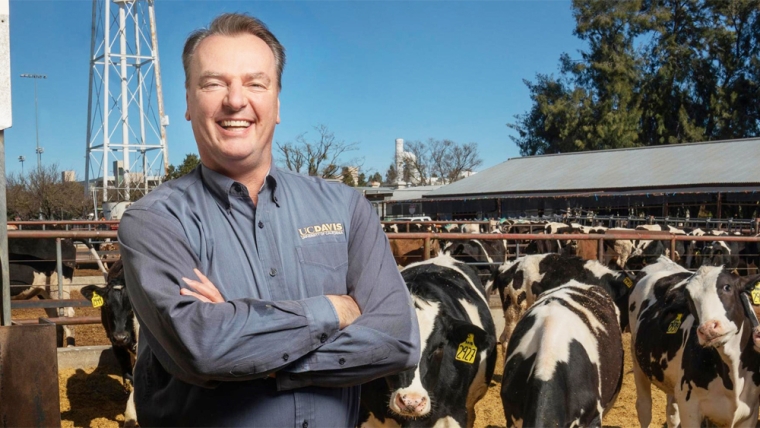
For too long, methane has been cast as the climate villain, and agriculture, particularly livestock farming has been caught in the crossfire. But according to Frank Mitloehner, Professor and Director of the Clear Center at the University of California, Davis, we’ve been measuring and misunderstanding methane all wrong. And it’s time we changed that.
“Methane is a unique gas,” Mitloehner explained in a recent interview. “It’s produced under very specific conditions and by very specific microbes, those that don’t tolerate oxygen. That’s why you find methane from sources like cattle, rice paddies, and landfills.”
At face value, methane sounds frightening. It’s 28 times more potent than carbon dioxide at trapping heat, molecule for molecule. But potency isn’t the full story. The big difference lies in methane’s lifespan.
“Methane lasts for about a decade,” said Mitloehner. “Carbon dioxide, on the other hand, can remain in the atmosphere for over 1,000 years. That difference in lifespan changes the warming impact dramatically.”
What’s often ignored in the debate is that methane doesn’t just accumulate endlessly like CO₂. It breaks down naturally over time, through a process called oxidation. So, if emissions from a constant source like a cattle herd remain stable, the amount of methane entering the atmosphere roughly equals the amount being destroyed. “That means it’s not adding additional warming,” said Mitloehner.
And here lies the crux of the issue: while we measure all greenhouse gases using a CO₂-equivalent metric (GWP100), this approach fails to account for the unique behaviour of short-lived gases like methane. As Mitloehner put it, “In my opinion, they shouldn’t be qualified in the same way. They are just very different pollutants.”
Current accounting methods overestimate the warming effect of methane by a factor of three to four, according to the latest Intergovernmental Panel on Climate Change (IPCC) report. This exaggeration distorts climate policies, disproportionately punishing countries like New Zealand, where farming is the backbone of the economy and methane is the dominant emission from livestock.
New Zealand’s cattle and sheep farmers have been made to feel like climate criminals. But if Mitloehner’s research tells us anything, it’s that they may actually hold a big part of the solution. “Livestock is not the solution,” he said, “but managing methane is the solution. And the livestock sector can absolutely be part of that.”
Indeed, by reducing methane, we can reduce warming, a result that doesn’t apply to long-lived gases like carbon dioxide. “If you reduce methane, you reduce warming. That gives us a really good opportunity in animal agriculture,” said Mitloehner.
In California, that opportunity has already become a reality. Mitloehner described how the state, the largest dairy producer in the United States, has slashed methane emissions from its dairy sector using a voluntary, incentive-based system rather than taxes or penalties. The California dairy sector were asked to cut methane produced by manure by 40% by 2030. Instead of threatening the industry with fines, the state offered grants and credits to help them innovate.
“What the government said was: we expect you to reduce emissions, but you choose how. If you do we will pay you. And it’s working,” Mitloehner said. “Our dairy industry is well on its way to meeting that 40% reduction. So far they’ve already achieved a five million metric ton reduction. The goal is seven million. That’s the world’s most aggressive methane law and it’s being achieved by working with, not against, farmers.”
Much of the reduction has come from dairy digesters, technologies that trap methane from manure and convert it into renewable energy. These alone account for 30% of California’s methane reduction target. “They’ve achieved that with less than 2% of the state’s climate investment funding. Dairy digesters are a cost-effective way of reducing methane from manure,” Mitloehner said.
What makes this even more striking is the contrast with many other countries, including New Zealand that continue to lean on the “stick” approach: regulation, taxation and punitive pricing mechanisms that create resentment rather than results.
“I’ve seen the stick approach fail in many countries,” said Mitloehner. “It’s not well liked by farmers and often not effective. The carrot approach like what we’ve done in California, is proving much more successful.”
The beauty of a voluntary incentive model lies in its flexibility. Farmers aren’t forced into a one-size-fits-all solution. They can choose from a toolbox of proven techniques, ranging from breeding to feed to management practices.
“Methane is a heritable trait,” Mitloehner explained. “You can select genetically for animals that emit less methane. That’s a permanent solution. Vaccinations are being developed. Even adjusting forage composition can help.”
These innovations could be game changers for grass-based systems like New Zealand’s, where our animals graze in open pastures rather than in barns. While solutions like manure digesters may be less applicable, other approaches like genetics are perfectly suited. “You just have to match the solution to the system,” Mitloehner said.
Yet these solutions require investment, support and perhaps most importantly, public understanding. Right now too many people believe livestock is the problem. But when managed well, livestock can help reduce climate change. That means flipping the narrative.
“We don’t want to ignore methane,” said Mitloehner. “I’m not saying that. But we need to understand that it behaves differently. If we reduce it by just 0.3% per year, then the sector responsible doesn’t contribute to additional warming. That’s achievable.”
With the right policy settings here at home, farmers could not only meet their climate targets-they could lead the world in doing so.
To get there, Mitloehner insists governments must stop treating farmers as culprits and start seeing them as partners. “You can’t achieve ambitious climate goals by alienating the people who feed us,” he said. “We need to be creative. We need the best science, and we need the best policy. But most of all, we need to work together.”
That starts with recognising the difference between short-lived and long-lived gases. It continues with targeted investment in new technologies. And it ends, hopefully with a thriving, productive, low-emissions livestock sector - one that is part of the climate solution not the scapegoat.
There’s a lot New Zealand can learn from California’s experience. The pathway is becoming clearer. The tools are available. We simply have to get this right. “For a country like New Zealand, where farming is so important, we cannot afford to get it wrong.”
Have a listen to the podcast to hear the full story.
Angus Kebbell is the Producer at Tailwind Media. You can contact him here.
8 Comments
Lord, it is so embarassing when NZ folks spout this nonsense. There is a huge cloud of super-warming methane in the sky because NZ has, for decades, had millions of farting, grass-eating animals. We top-up that cloud as fast as it breaks down (into less warming gases). We can implement whizz bang tech A, B, and C, and that might mean our methane cloud shirnks a bit, but we're playing at the margins here.
Is it embarrassing not knowing which end of an animal is which?
lol, it's both, but, yes the majority is burps!
We are not even at the margins.
"New Zealand was a net CO2 sink of −38.6 ± 13.4 million tonne C yr−1"
https://agupubs.onlinelibrary.wiley.com/doi/10.1029/2023GB007845
So, the huge cloud of methane in the sky is actually not there? Wow.
Jonny Foe,
Current accounting methods overestimate the warming effect of methane by a factor of three to four, according to the latest Intergovernmental Panel on Climate Change (IPCC) report.
Could you comment on that? Here is a quote; " The country's carbon emissions are considerably more important than our methane emissions". That was written in an email to me from Professor James Renwick, one of NZ's leading climate scientists.
Here's another quote; "For Frame and many other climate scientists, methane isn't exactly the global warming bogeyman many believe". Professor David Frame is another of our leading climate scientists.
Perhaps you would like to comment on these quotes.

We welcome your comments below. If you are not already registered, please register to comment
Remember we welcome robust, respectful and insightful debate. We don't welcome abusive or defamatory comments and will de-register those repeatedly making such comments. Our current comment policy is here.